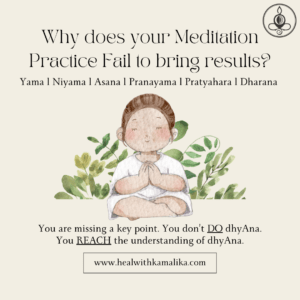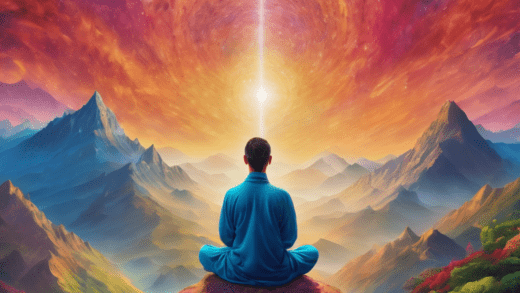Why does your Meditation Practice Fail to bring results?
To MEDITATE is to CONTEMPLATE.
As per Oxford Dictionary the word Meditate is a verb. Meaning to think deeply, usually in silence.
You also may have heard the term premeditated.
Premeditated refers to something that has been carefully planned or thought out in advance.
Thus, the word MEDITATION does not mean Dhyana.
However, due to the usage of it, the word Meditation points towards Dhyana.
Then, what is dhyAna?
dhi- mind
yAna- movement
Together it is dhyAna – mind that is constantly in movement.
How is it then, you are going to practice or do something that’s an explanation of a phenomena, which is happening anyway. Without you doing anything.
When I say or you say or whoever says or utter the word dhyana where is it asking you to do something?
Now, the question of something not working out will only arise when it is associated with a desired outcome.
What is the most sought after outcome for the desire or need to Meditate?
Mental peace from a chaotic mind or respite from overthinking.
Do you realise that thoughts are natural & involuntary. If you knew how not to overthink, wouldn’t you have controlled it by now? Who would voluntarily torture themselves. I know I sure wouldn’t.
Overthinking is not the problem. The problem is it’s after-effects of discomfort.
If it’s a happy thought you don’t mind thinking about it right?
-When you can’t stop thinking about the person you love and they love you back.
-When you are planning your birthday trip with friends and the itinerary is the only thing on your mind.
-When you have read an excellent book or watched a lovely movie and are thinking about it for days.
These thoughts are soothing, calming & brings joy to you. Even if you are not in the present moment, and drifted away to a past memory or plans of a joyous future, you don’t seem to mind it or even notice it.
All these are loops or trains of thoughts running on your mind. You don’t seem to have a problem with them. Do you?
Clearly, everyone is blaming overthinking when it is the quality of thoughts that’s the real challenge, that’s troubling you or taking your ease away, making you feel jittery and unstable. Taking you away from the present moment, and not the fact the you are overthinking.
Now, if you went through a breakup or a divorce and you loved the person, the constant thoughts are like torture. Same person, same you, same city, same weather, same thoughts or memories but your situation changed and the same happy memories turned into a torture or severe mental and physical discomfort.
I am often asked what technique do I follow?
What should I answer? There is no technique. Because there is nothing to follow or perform.
The Yogasutras by Maharshi Patanjali starts with a powerful thread or sutra – अथ योगानुशासनम् ॥१.१॥
Atha Yoga Anushasanam.
Literally translating to – And now the Self Discipline of Yoga.
Why does it start with this and not something else?
My analogy?
Civilised humans, irrespective of the time they are in, are primarily troubled by their own mind that is constantly moving. That won’t stop or even listen to their own selves. Until we understand how we function and how to conduct ourselves to live with balance and joy, we cannot find daily fulfilment. Neither would the society be in order.
Now why Yoga?
Yoga literally means to join or a union. If you think it through every single experience is through a situation or a person. But the experience is happening within us. If you go even deeper, then ultimately we are the expression of the Planet. We are not just a part of the planet. We are the Planet. Each one of us. This realisation leads us to being considerate & compassionate towards each other. When we are not just one big family, we are one unit, one consciousness where is the threat or a competition?
Maharshi thus gives us practical steps that eventually leads us to this realisation of dhyAna – ultimately being in Samadhi thereby in Yoga.
YAMA (Self Discipline):
1. Ahimsa – non-violence
2. Satya – Truthfulness
3. Asteya – non-stealing
4. Brahmacharya – being on the path of constant expansion (the divine)
5. Aparigraha – non-covetousness
NIAMA (strict regimen) :
1. Shaucha – Ceanliness (inner & outer)
2. Santosha – contentment
3. Tapah – penance
4. Svadhyaya – Study if the self
5. Ishvarapranidhana – abiding in the divine
ASANA (your place-in this moment) – correction of your posture brings sthirata (stillness) & sukhata(ease) this leads to asana(being here, being present)
PRANAYAMA – regulation of the breath. It is the breath that is truly making a difference. The body would instantly stop to function if the breath stops and we will immediately drop dead. Thus, by regulating the breath we bring further stillness and calm inside our body.
PRATYAHARA – sensory withdrawal – turning onwards physically with the help of our senses is a clear way of reestablishing our connection with ourselves. Because we are experiencing what is outside through our five senses and this directly governs our perception abilities.
DHARANA – concentration- focus. When we try to focus our mind naturally drifts away. This final step leads us to understanding that our mind naturally is in constant movement.
dhyAna – when you start to observe this constant happening, there is a space that creates between the one that is seeing and that being seen. This distance makes you understand your natural response system. This distance makes you detach from deep attachment to your thoughts, emotions and feelings. With prolonged practice you finally come to terms with your belief system, you inherent fears, your rigid insecurities etc.
So far you have been operating through them. But now you know that with patience and pause this system of response can be altered, thereby altering your immediate experiences and your future. This slowly brings balance and order in your body, mind and life. And you reach –
Samadhi – Equanimous Mind. Finally you have arrived in the present moment.
Thereby, any train of thought, good or bad, will cease to make you miserable or over enthusiastic because you by now know for a fact that –
A. No thought is the present moment and
B. No thought lasts a lifetime. They are impermanent and involuntary.
If you simply watch the traffic of incoming and outgoing thoughts, they will slowly stop to affect you. You will always have enough space or room to accommodate and process difficult emotions with grace and poise. Leading you back to being present.
स्थिरसुखम् आसनम् ॥२.४६॥
Sthira Sukham Asanam – When you are still and at ease, you are present.
I am on a mission to break the human chain of stress. To facilitate it I teach mindfulness for free. Sign up.
If you want to join our Personalised Coaching Programs consider going through our detailed Links.















Recent Comments